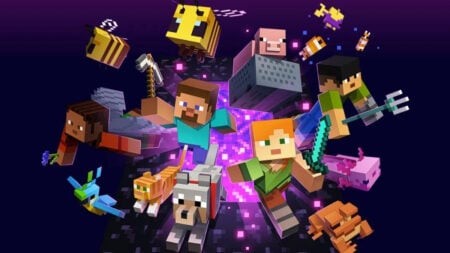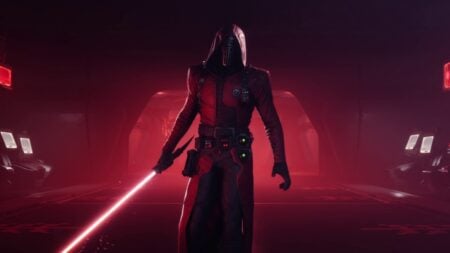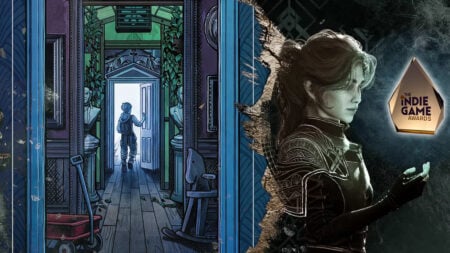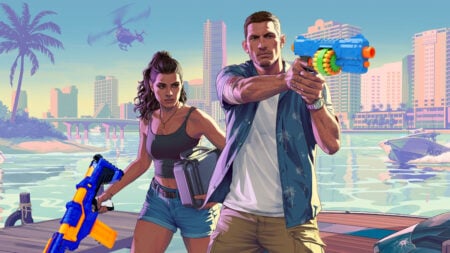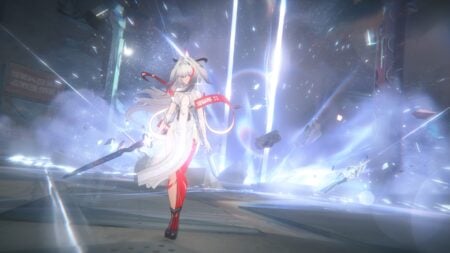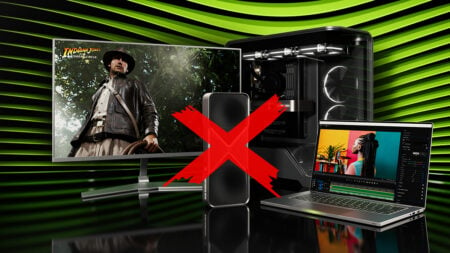Skip To...
Adventure is a loaded word, often bearing different meanings depending on who speaks it. It can be an enticing call to uncharted worlds where you discover yourself. It can be a perilous journey made bearable and meaningful by your companions. In the case of Grandia and Grandia II, it overlaps those experiences, often within each title.
My experiences with Grandia were uncertain, as it’s been decades since these two seminal roleplaying games hit home consoles. As the reviewer, it’s an adventure to dive into these games and either rediscover my love for a beloved all-timer or even see if it holds up or is simply clouded by nostalgia. The Grandia HD Collection facilitates this, packing two epics spanning dozens of hours each, now on
The Hero’s Journey

Despite two fairly different plots and wildly different overall tones, both Grandias feature a layered male protagonist who grows a roster of companions. In terms of Japanese roleplaying games, or JRPGs, this is a pretty common trope, along with their respective calls to adventure.
Justin, the protagonist of the first game, lives in a society that looks up to the Adventurer’s Society. He sees membership with them as a means to an end, as he wants to become a great adventurer like his father and his grandfather before him. Justin is an idealistic, noble, heroic young lad of 14 whose naivete is quickly offset by his unflappable optimism. It wins him the admiration of his party members and even his first love. Justin’s call to adventure means running away from home to venture past the mysterious End of the World.
Meanwhile, Ryudo is the protagonist of Grandia II and is nearly the polar opposite of Justin. He’s a pragmatic, somewhat sardonic Geohound, a mercenary expected to fulfill their contracts without question. Ryudo’s biggest roadblocks, you will realize, lie in latent trust issues, shown as he meets and interacts with new party members. He’s an angsty, tough older teen whose initial task is to guard Elena, a Songstress for the Church of Granas. Harrowing tragedy complicates their mission, and soon Ryudo finds himself inextricably linked to Elena while developing a sense of purpose.
Two Sides of the Same Grandia Coin

Both stories are engaging, quickly winning over players, although the first Grandia holds my heart and never lets go. The particularly wonderful aspect of Justin’s story, along with meeting the girl of his dreams and quickly winning her over, is his coming-of-age. Players grow up alongside Justin in this timeless story of a boy discovering a vast world beyond his imagination. Even when faced with cruelty and destruction, Justin is steadfast and open-minded.

Justin sits among my favorite JRPG protagonists ever, a quixotic example of an undeniably good hero. Ryudo, while rough around the edges, develops in a similar direction, opening himself up to others and discovering his empathy. He’s all of us when we’re on the cusp of adulthood, assessing who we want to be for the rest of our lives. When asked whether I prefer Justin or Ryudo, I’m tempted to say, “Yes,” but the point is, they’re both excellent, with a slight preference for Justin.
A Battle System Masterclass

While Grandia I+II are not the greatest JRPGs of all time in my eyes (Chrono Trigger takes that crown) they remain uniquely strong. Even more than Chrono Trigger, their battle mechanics lie beyond generic ATB attacks + skills + magic + thrown items. However, I’d go as boldly as to say it’s possibly my favorite battle system of any JRPG of the era. It’s simple, yet it boasts remarkable depth.
Each game cleverly incorporates the combatants’ place on the battlefield. Proximity to your enemy can make or break your chances of hitting or getting hit in melee attacks. Choosing the defend option isn’t simply a matter of blocking, as you can choose to guard or move out of the enemy’s path.

Along the Wait, Command, or Action stages you can effectively cancel your opponent’s actions, but so can they. If you play carefully and don’t get ambushed at the start, you can crush the opposition quickly. Grandia II refined this, adding greater weight and density to boss fights. You can level up your magic, techniques, and characters separately in some cases, which feels like a touch of Fire Emblem.
Some of the Best NPC Interactions Ever

But beyond battle systems, other JRPG mechanics help Grandia shine. I often take this for granted, but a JRPG enhances its worldbuilding with strong NPC interactions. Grandia I+II does a wonderful job of this, with bespoke conversations with even generic villagers. That’s before even getting into amazing moments like when the letter from Justin’s mother, or most of the characters in Gumbo, whose villagers are afraid to find lovers until they encounter you (for unfortunate reasons).
Between major events, these interactions change sharply between characters. I rarely seek out other villagers before advancing the plot in other games, but this adds a feeling of reality as if these NPCs are as invested in the story as you are. This feels incredibly rare, aside from wonderful recent examples like Baldur’s Gate 3.
Players seem more keen than ever to see NPCs as a hindrance, especially since they sometimes affect the game’s performance, like in Dragon’s Dogma 2. NPC interactions are an exceedingly rare strength in RPGs, often serving as fluff. When executed like they are in Grandia, they become exemplary in making a game world feel real.
The Visuals: Timeless Beauty

Grandia was originally produced for the Sega Saturn, with a later port for the PlayStation allowing the West to play it. The HD version of this game essentially combines the strongest elements of both ports. Meanwhile, Grandia II HD is a port of the Dreamcast version, which was vastly superior to its original PC and PlayStation ports. But despite the decades since either of these games was released, the game still has wonderful visuals when they count.
These include breathtaking early 3D visuals, including a forest chillingly petrified and its denizens. They include a lovely showcase of the Dreamcast sequel’s powerful graphics alongside their neat anime visuals.
That’s not to say there aren’t odd limitations. It feels sometimes jarring seeing some of the special attacks, more so in Grandia II, which feel almost Lynchian in how cheesy or out of place they are. There were certainly higher-fidelity games of each respective Grandia’s era, yet each game makes full use of its resources. The first game has animations for its sprites, which are seemingly only used in one or two instances, an intimate and lovingly detailed quality.
There’s even an impressive dungeon sequence I liken to a combination of the Great Wall of China and the Tower of Babel. These experiences were achieved in 32-bit and 128-bit graphics and age well against modern counterparts. Finally, the framerate and feel of playing Grandia II are excellent and feel truly enhanced. It showcases how quickly the game improved on its predecessor.
The Music: Grandiose Yet Serene

Growing up with my background in classical music, I always appreciate a sweeping orchestral soundtrack. Grandia does this wonderfully in both of these installments, with particularly strong tracks like ‘Edge of the World’ or ‘A Deus.’ There’s a soul to this music, utterly familiar, reserved in moments of solemnity, and blaring in moments of triumph.
Beyond the dichotomy of tones within Grandia I+II, the music jumps in so many directions, especially in the sequel. Neither soundtrack feels like a stuffy night at the symphony, but rather a genre-blending experience yet still rooted in classical romanticism. But its greatest moments use music to coax your heart and tear ducts open.
Few moments do as good a job as Grandia’s OST in creating an audio backdrop that doesn’t steal focus. These moments include the beautiful transition from the sea adventure fanfare to a heartfelt, silent goodbye. This, and the wonderfully tender moments he shares with Feena when the pair realize they might just be soulmates, are punctuated perfectly with ethereal violin solos.
There are so many other moments like this in Grandia I alone before getting into the absolute genre-blending bops of Grandia II. Seriously, as hauntingly beautiful as the OST of the first game is, the sequel has some incredible battle themes.
Do Grandia I and II Hold Up as Classics?

This was my biggest fear, especially as I dive into games so highly regarded that originated during my childhood. After all, even all-time classics like Final Fantasy VII look rough around the edges when compared to their massive remakes. An HD collection is a hard sell when fans could happily experience a ground-up remake on the scale of Resident Evil 2.
But frankly, these titles were already excellent, and due to the high degree of polish on each title, they’ve aged wonderfully. It was an adventure rediscovering these classics and seeing how they stand the test of time. The music is as strong as ever, and its most iconic themes are something I’d happily experience in a concert hall. The graphics are refined enough to feel like a product of their era yet play to their unique strengths. Playing these on the
There are flaws to this game, but ones that can be easily overlooked. Being a product of the ’90s into the 2000s, they naturally have a forgettable English dub. It sounds vaguely like actors paid to read individual lines instead of as part of a dialogue. However, the easy option here is to switch to Japanese audio, as this dub’s actors have more flair and conviction in their delivery.
Conclusion: A Welcome Reminder of the JRPG Heyday
For somebody indulging their inner child seeking adventure, this embodies the classic gold standard of a romantic flight of fancy. The emotional impact these games have on me is difficult to articulate. Playing them feels akin to a certified Disney moment, like when Anton Ego took one bite of ratatouille. It instantly transported me to my childhood in a meaningful way. The collection is sublime not because it meets lofty standards and moving targets of the modern gaming landscape but because it’s an amalgam of artistic expression and passion.
NPCs are assets, not obstacles, in the Grandia HD Collection. The music is beautiful but used as a backdrop, allowing you to focus on the game’s diverse worlds. Characters from each game are charming, with the first game having a better protagonist and the second having a superior supporting cast. The battle systems are still unique to this day, and these games are now fully democratized to all of the major home gaming markets. It’s timeless for connoisseurs of the classics and essential for those seeking a truly unique JRPG.
Grandia HD Collection (Xbox One and Series X|S)
NPCs are assets, not obstacles in the Grandia HD Collection. The music is beautiful but used as a backdrop, allowing you to focus on the game's diverse worlds. Characters from each game are charming, with the first game having a better protagonist, and the second having a superior supporting cast. The battle systems are still unique to this day, and these games are now fully democratized to all of the major home gaming markets. It's timeless for connoisseurs of the classics, and essential for those seeking a truly unique JRPG.
Pros
- Key visual moments remain timeless
- Brilliant, idiosyncratic battle system
- Varied stories and protagonists between games
- Some of the most beautiful yet understated RPG musical backdrops
Cons
- An English dub that pales in comparison to the Japanese dub
- Special attack visuals feel occasionally out-of-place


